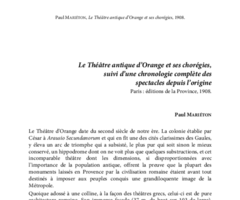Pallas Athénée op. 98
Hymn for soprano and orchestra premiered on 11 August 1894 at the Roman Theatre of Orange.
The 1890s saw Camille Saint-Saëns take a close interest in ancient music. In 1892, he submitted a study on the lyre to the Institut, based on the observation of Greek statues. In 1893, at the request of Paul Meurice and Auguste Vacquerie, he composed incidental music to their tragedy Antigone (after Sophocles) for the Comédie-Française, attempting to imitate the style of the ancients. To this end he had at his disposal contemporary studies by François-Auguste Gevaert, notably his Histoire et théorie de la musique de l'Antiquité (1875–1881). The following year, his hymn Pallas Athénée served to accompany another play by Sophocles, Œdipe-Roi, translated by Jules Lacroix. However, the context of the premiere was very different: it took place at the Roman Theatre of Orange, as part of the fifth “festival” organised by Paul Mariéton, on the initiative of the Félibrige and Cigale associations. This edition particularly honoured Saint-Saëns: the day after the performance of Œdipe-Roi, Meurice and Vacquerie’s Antigone was given. Beyond being an exercise in ancient style, the hymn performed by Lucienne Bréval (who was also the dedicatee) carried a political message that fitted in perfectly with the festival’s project. As “Greece’s sister”, Provence was depicted as a place of renewal where the goddess would be able to “awaken the souls of the ancient gods”. In the face of a German culture deemed expansionist and threatening, the French proclaimed their filiation with the cradle of Western civilisation. In return, the work was celebrated in Greece at a festival in honour of Saint-Saëns organised in 1920.

